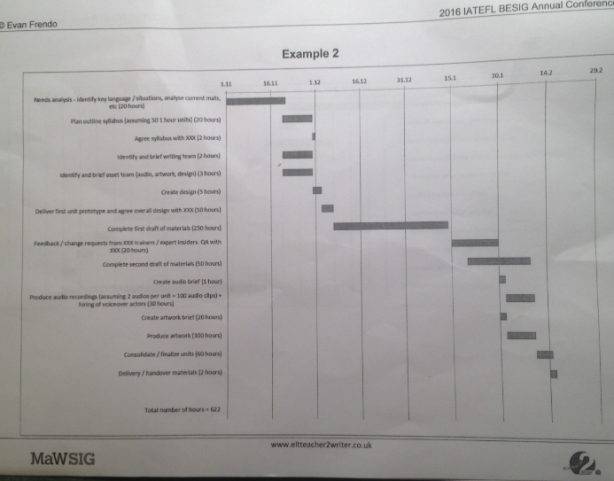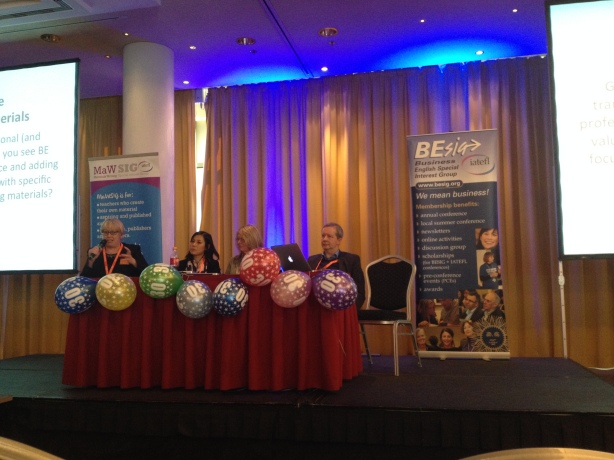The second pre-conference event at the BESIG annual conference 2016 was on Creating excellent ELT materials. In this session five experienced ELT authors who have written teacher training modules published by ELT Teacher 2 Writer gave 15 minute workshops related the topics of the modules they’d written. This was a whirl of brilliance: a fast-paced but at the same time very hands-on session packed to the brim with invaluable insight.
Below are my notes from the mini-workshop on How to write writing activities by Rachael Roberts, who has also written a book with the same title:
Rachael started by pointing out that writing activities are often left out or ‘done for homework’. In one-to-one context writing is also ‘weird’ because it’s silent. But increasingly more and more communication is done through writing, and so Rachael is passionate about teaching writing.
Sometimes when the learners are set a writing task, they aren’t given any support and so they have to ‘take a plunge’. In contrast, Rachael is going to focus on how to make the task manageable, i.e. scaffold the learners.
To break down the writing task, we need to think about the ‘ingredients’ of a piece of writing and
- select which ingredients are key for the task;
- decide in which order to approach them.
Key ingredients
Example: for a letter of application key ingredients would be the register and set phrases. If, on the other hand, you’re writing a report, it’s extremely important to think about the organization.

Regarding lexis, there might be two ‘kinds’ of vocabulary that are key to the task:
- language to help organize the text and
- topic-related language.
For (1) the best thing to do is to have a model. Possible scaffolding: highlight the key expressions in the model and set the task for the learners to sort the expressions.
For (2), Rachael looks at samples of texts on the topic and puts them into a word cloud. This might reveal some vocabulary that isn’t obviously associated with the topic E.g. in this example you see that climate change is related to migration and crisis.

Logical order
To help us explore the typical order of a writing lesson, Rachael invited us to order the following stages of writing an essay:

Here is the ‘key’ – a layout of a writing lesson:
- Tasks to activate schemata and, possibly, introduce some language
- Read a model essay.
- Start analyzing the essay: identify the thesis statement; identify the topic sentences;
- Focus on grammar: identify the passive statements (focus on grammar after focus on meaning and context); practice passives (rewrite a set of sentences, using passives where appropriate);
- Do the actual writing: the plan, a draft, check against a checklist and revise the draft.

It seems that in this session Rachael has achieved the impossible and distilled the nuts and bolts of teaching writing to a fifteen minute workshop that included a practical element. An extremely useful, clear and concise framework to keep to hand.
As I mentioned above, this workshop was based on a module that Rachael wrote for ELT Teacher 2 Writer. It’s now also a chapter in a print book, which was great news for me, because I vastly prefer hard copies to ebooks – so I grabbed the book the moment it came out. I’ve just finished reading the chapter written by Rachael, and I really really enjoyed it.

In the book, it’s a 38 page chapter (in other words, quite manageable for even a very busy teacher), and just like the workshop that Rachael gave, it’s an extremely clear, concise and hands-on take on creating writing activities. About a quarter of the module is devoted to an overview of activities and task types that might be used to help learners with the different ‘key ingredients’ of a writing task. Rachael also touches on the practical consideration of
- how to choose which approach to teaching writing to use
- how to analyze and write model texts
- the ways writing for digital might be different from writing traditional activities, and more.
She mentions a lot of pitfalls to avoid, and also includes over a dozen practical tasks for the reader that really help process the ideas in the text. All in all, I can recommend this module not only to teachers who actually create writing materials, but also to anyone who teaches writing and wants to gain deeper understanding of how coursebook materials on writing work.













 This year I was very lucky to go to Manchester to attend the IATEFL Conference. While there, I wrote up summaries of over 20 talks and workshops – I’ve decided to sort them by topic area and put the links in one post to make them easier to navigate.
This year I was very lucky to go to Manchester to attend the IATEFL Conference. While there, I wrote up summaries of over 20 talks and workshops – I’ve decided to sort them by topic area and put the links in one post to make them easier to navigate.


 Jo-Ann Imp >>> V Imp. Before taking lessons, Jo-Ann thought it’s not that important and she had a worry that sometimes teachers overpraise.
Jo-Ann Imp >>> V Imp. Before taking lessons, Jo-Ann thought it’s not that important and she had a worry that sometimes teachers overpraise.




